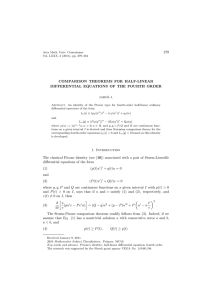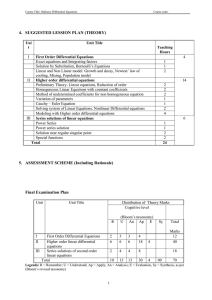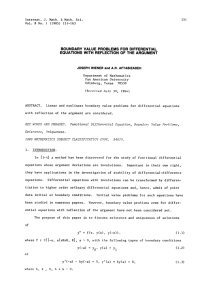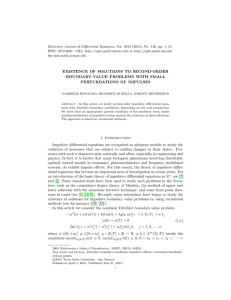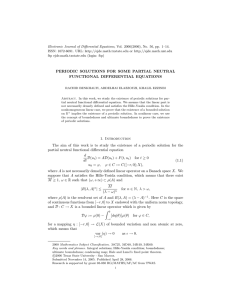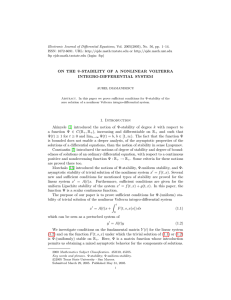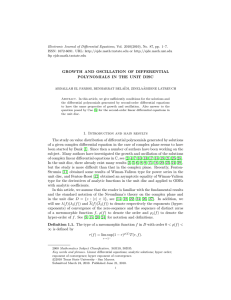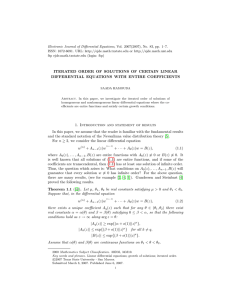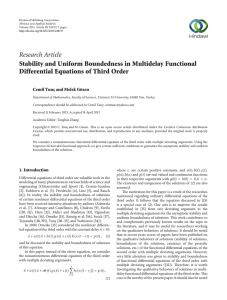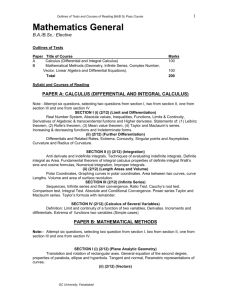SOLUTIONS DELAY DIFFERENTIAL ON STABILITY AND BOUNDEDNESS OF OF
advertisement
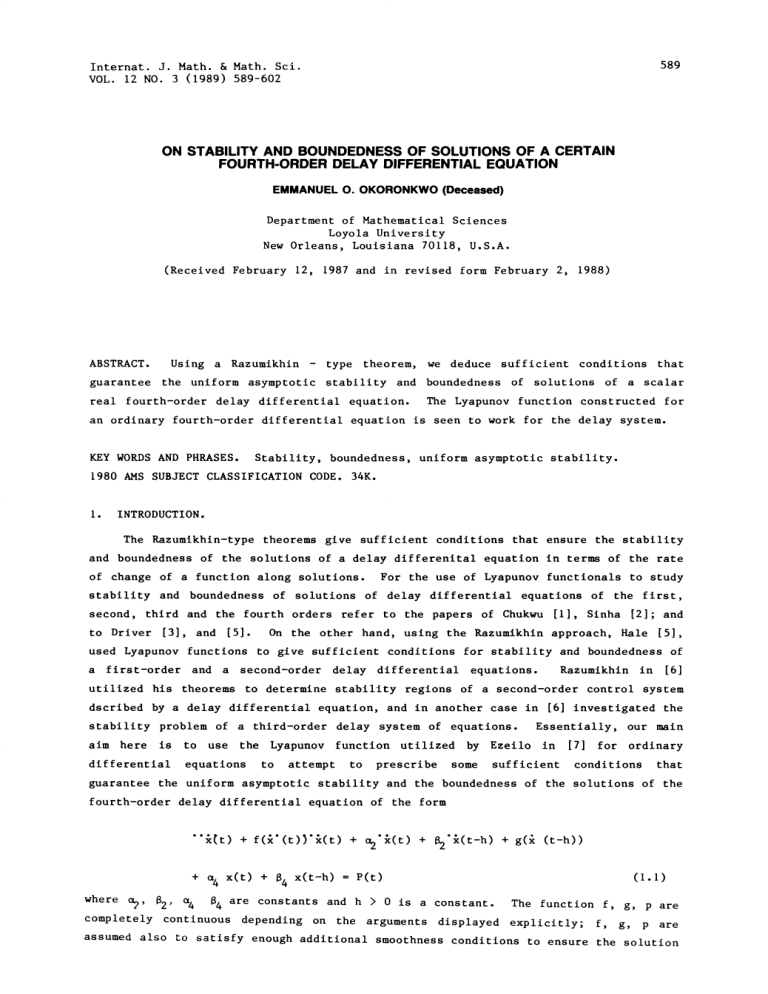
589
Internat. J. Math. & Math. Sci.
VOL. 12 NO. 3 (1989) 589-602
ON STABILITY AND BOUNDEDNESS OF SOLUTIONS OF A CERTAIN
FOURTH-ORDER DELAY DIFFERENTIAL EQUATION
EMMANUEL O. OKORONKWO (Deceased)
Department of Mathematical Sciences
Loyola University
New Orleans, Louisiana 70118, U.S.A.
(Received February 12, 1987 and in revised form February 2, 1988)
ABSTRACT.
Using a Razumikhin
type theorem,
we deduce sufficient conditions that
guarantee the uniform asymptotic stability and boundedness of solutions of a scalar
The Lyapunov function constructed for
real fourth-order delay differential equation.
an ordinary fourth-order differential equation is seen to work for the delay system.
KEY WORDS AND PHRASES.
Stability, boundedness, uniform asymptotic stability.
1980 AMS SUBJECT CLASSIFICATION CODE. 34K.
I.
INTRODUCTION.
The Razumikhin-type theorems give sufficient conditions that ensure the stability
and boundedness of the solutions of a delay differenital equation in terms of the rate
For the use of Lyapunov functionals to study
of change of a function along solutions.
stability and boundedness of solutions of delay differential equations of the first,
second, third and the fourth orders refer to the papers of Chukwu [I], Sinha [2]; and
to Driver
[3], and [5].
On the other hand, using the Razumikhin approach, Hale [5],
used Lyapunov functions to give sufficient conditions for stability and boundedness of
a first-order and a second-order delay differential
equations.
[6]
Razumikhin in
utilized his theorems to determine stability regions of a second-order control system
dscribed by a delay differential equation, and in another case in [6] investigated the
stability problem of a third-order delay system of equations.
aim here
is
differential
to
use
Essentially, our main
the Lyapunov function utilized by Ezeilo in
equations
attempt
to
prescribe
to
some
sufficient
[7] for ordinary
conditions
that
guarantee the uniform asymptotic stability and the boundedness of the solutions of the
fourth-order delay differential equation of the form
"’t) + f(’(t))’(t) +
+
where
4
p, 82 4 84
x(t) +
84
x(t-h)
2"(t)
+
82"(t-h)
P(t)
are constants and h
>
+ g( (t-h))
(1.1)
0 is a constant.
The function f, g, p are
completely continuous depending on the arguments displayed explicitly; f, g, p are
assumed also to satisfy enough additional smoothness conditions to ensure the
solution
E.O. OKORONKWO
590
of (I.I) thoug any inatlax oata
shall
consider
stability
of
the
We
continuous in the initial data and in time.
is
solutions
trivial
of
(I.I)
for
the
0.
case p
Corresponding results are deduced for a real fourth-order delay differential equation
As a consequence, a generalized Routh-Hurwitz condition
with constant coefficients.
for a delay fourth order linear equation is deduced when the delay is sufficiently
small.
2.
PRELIMINARIES.
Dots such as are in equation (I.I) denote differentiation with respect to t.
E
n
is an n-dimensional linear vector space over the reals with norm for any x e E
Ixl.
written
For h
C ([-h,0],
0, C
We designate the norm of an element
If o e E, a
x
)
te
E
n
with the topology of uniform convergence.
If II
and defined by
II II
Sup
-h 840
I(8) I"
h,o + a], E n) then for any t e [, + a] we let
x(t+8), -h 4 8 (0. If D is a subset of E E, and
xt(8)
is given function, then
(t)
is
by
0 and x e C([
C be defined by
f: D
m n)
n
f(t,x t)
(2.1)
a retarded functional differential equation on D.
Note that (I.i) is a special
case of (2.1) and it also includes ordinary differential equations when h
0.
DEFINITION 2.1. A function x is said to be a solution of (2.1) on [o + h,o + a) if
> 0 such that x e C( h,o + a], E n), (t,x t) e D and x(t)
e C, we say x(o,) is a solution
[o,o + a]. For given o e E,
of (2.1) with initial value # at oor simply through (o,) if there is an a > 0 such
that x(o,) is a solution of equation (2.1) on [-h o+a) and x (o,)
DEFINITION 2.2.
0 for all t e E,
0 of
then the solution x
Suppose f(t,O)
I)
(g)
is
(2.
said to be uniformly stable if for any o
E,
> 0, there is
>0
there
o
are
E and
a
satisfies (2.1) for t
II II
.
llx <, )ll
<
<
x
0
uniformly asymptotically stable if it is uniformly stable and there is a b
O,
llxt(o,)l;
DEFINITION
any
>
2.3.
0 there
is
)
o + T()for every o e E.
The
a B
0 such
II
a
for t
>
solutions
B(e)
>
x(o,)
0 such
of
that
(2.1) are uniformly bounded if
for
all
e E,
e C and
II #II
for
% we
[8]) for stability of
V:
E x C + E is continuous
if
The following theorems (due to Razumikhin and Krasovskii
(2.1) are reproduced from [5].
First
(2.1) through (o,), then we define
V(t (0)] where x(t ) is the solution of
[V(t+r, xt+r (t )
+
0
solutions
of
x(,)
V(t, (0))
is the solution of
and
Limr
(2.1) through (t,).
n
E takes E x (bounded sets of C)
C
PROPOSITION 2.1. (Razumikhin) Suppose f: E
n
Suppose u, v, w: [0, =) + [0,) are
into bounded sets of E and consider (2.1).
O.
v(0)
u(0)
continuous nondecreasing functions, u(s), v(s) positive for s > 0,
If there is a continuous function V: E x E
n
E such that
STABILITY AND BOUNDEDNESS OF SOLUTIONS OF DIFFERENTIAL EQUATIONS
V(t x)
u( x
(t, (0))
if
E, x
E
(2.2)
E
(0)I),
-w(
V(t,(0)), e
V(t+8,(e))
v( x ), t
(2.3)
solution x --0 of (2.1) is uniformly
[-h,0], then the
E
591
stable.
(Krasovskii) Suppose all the conditions of proposition 2.1 are
PROPOSITION 2.2:
>
satisfied and in addition w(s)
function J(s)
>
>
s for s
-w([ (0) I)
(t, (0))
>
0.
If there is a continuous nondecreasing
V(t+8, (8))
if
<
J(V(t, (0)) 8
E
[-h,0],
0 of (2.1) is uniformly asymptotically stable.
then the solution x
If u(s)
(2.4)
as
0 is also a global attractor for (2.1) so that every
s *-, then the solution x
solution
0 if s
0 such that condition (2.3) is strengthened to
x(o,#) of (2.1) satisifes
xt(o, )
We shall investigate (I.I)
0 as t
0 respectively in the equivalent forms
for p E 0, p
(t)
y(t)
#(t)
(t)
w(t)
(t)
-w(t)f(z(t))-a2z(t)-g(y(t))-a4x(t)
0
-h
and
3.
2
g’(y(t+8))z(t+8)de
#(t)
z(t)
(t)
w(t)
(t)
-w(t)f(z(t))-a2z(t)-g(y(t))-a4x(t)
+
-h
82’ a4
4
+
+
0
0
w(t+)d+84
(2.5)
-h
-h
y(t)
0
2
y(t+8)d8 +
84
(t)
82
where a
0
0
w(t+8)de +
82
+
y(t+)d +
-h
g’(y(t+))z(t+e)d + p(t)
(2.6)
-h
84"
STATEMENT OF RESULT.
Assume that
THEOREM 3.1.
(i)
the constants
a
2
(ii) f()
>
0, a 4
a
>
>
0 and 0
0 for all
< al, a3, Co,
,
and
[ala2-g’()]a3-ala4f(z(t))
M
g()/
c
o >
a
3
>
0 for all
0 for all
,
z(t).
0.
(3.1)
592
E.O. OKORONKWO
(iii)g(0)
g’
]g’(n)
0
M for all n, and
()-g()/ I
for all
(
#
I
0 where
is such that
z(t)
(iv)
where
[-7 0
f()d] -f(z(t))
for all z(t) # 0
2c
(3.3)
2
ala 3
Furthermore,
(v)
>
if q
e +
d
>
and where
I/al;
r
rain
+
2
where
(3.4)
a4/a3
2 )’ 2aia3d0 ]
2a4c 0 I)’ a
2c0
2
4-0
a a
ala 3
3
a3
L4a4d0
d0(al,a2,a3,a 4)
Co, d o
d
[l,dl,d 2]
d--max
0 is defined by
e
wltn
[82,84,M],
I, 8--max
constants,
positive
c0
%1’
(3.5)
constants,
nonnegative
and
with p defined by
p
rain
[ a3e -3- al’
Co
6ala]’
then the condition Bdqh
<
(3.6)
p.
holds and the trivial solution of (2.6) is uniformly asymptotically stable.
that
>
> 0, a 2 > 0, a 3 > 0, a 4 > 0, c O > 0, d O
Consider the special case of (I.I) namely
since a
positive.
0, by
(3.2)
and
"’’(t)+a’(t)+j2 (t)+B (t-h)+a3{(t-h)+4x(t)+84x(t-h):
where
al,2,82,a3,4,84
trivially with
a
>
0, a 2
%1
(2
are constants.
0.
%2
+
82) >
Then condition (iii) and
(3.3),
0
d2f(z(t)
>
0, a 4
84) >
+
(?4
2
(ala2-a3)a3-ala 4
0,
3
a2 al
ala 4
a3
c
+
(a
a3)
e
)
c
We can therefore choose d o
+ a 3) so that e
(a
Hypothesis (v) now becomes
c
<
o
c
o
[6a l(a + a3 ), 6a3(al
max [82 84 a 3],
where 8
max [l,d l,d2], and
d
a
4
d2 e +__
a
dl e +I
a
3
Bdqh
rain
(3.7)
Conditions (i) and (ii) reduce to
0, a 3
a
dlg,(
is
(iv) are fulfilled
> co
If we use (3.4) we find that
a2
Observe
+
o
2ala3(al
a3 )]
o
ala3"
+ a 3)
(a
+ a 3)
.
>
0.
STABILITY AND BOUNDEDNESS OF SOLUTIONS OF DIFFERENTIAL EQUATIONS
Therefore
the
sufficient
for
conditions
all
(3.7)
to
e
0
of
solution
be
593
uniformly
asymptotically stable are
(i)
the Routh-Hurwitz Criteria
>
a
>
0, a 2
a
ala 2
(ala 2
>
3
a
>
0, a 4
3)
>
0, a 3
a
a
3
0
0
2
a
c
4
o >
0
>
(ii) q
c
8dqh
<
c
o
[.6al(al + a3
rain
o
6a3(al
+ a 3)
Hence all roots of the equation
#
+
aI%3 2%2 + 82 e-hhx2 + a3Ae
+
Ah
+
4
+
B4
(3.8)
will have negative real parts if conditions (i) and (ii) hold. If p
Theorem 3.2.
0, we establish:
(v) of theorem 3.1 hold and if
If the conditions in the hypotheses (i)
urther
IP(t)[
for some m
4.
>
(3.9)
m
,
0 and for all t
then the solutions of (2.6) are uniformly bounded.
THE FUNCTION V
V(x(t), y(t), z(t), w(t))
Lyapunov function V V(x(t), y(t), z(t), w(t)) by
Define the
2V
a
4
d
2
x
2(t)
+
a4d l)y2(t)
(a2d 2
y(t)
+ 2
g(n)d +
0
z(t)
f()d +
-d2)z2(t) + 2d 2 y(t)w(t) + 2 0
+ dlW2(t) + 2a4x(t)y(t) +
2a4d x(t)z(t)
+
(a2d
+ 2z(t)w(t)
z(t)
+ 2d 2 y(t)
f()d +
0
2dlZ(t)g(y(t)).
(4.1)
a
4
with e defined by (3.5). The proofs of Theorems 3.1
e +
and d
2
a
and 3.2 rest on the function V defined by (4.1) and which was utilized by Ezeilo in
where d
e +
I___
a--
[7].
LEMMA 4.1.
Given the hypotheses (i)
u,v:[O,)+[0,), u(s), v(s) positive for
u([x[) V(x(t), y(t), z(t), w(t)) ( v( [x[ ).
functions
nondecreasing
u(0)=v(0)--0, such that
PROOF.
a
rain
3
[4a0
(
2a4c 0
2
ala 3
Then, by the analysis in [7], V(0,0,0,0)
B.1
>
s
>
0
with
Take
E
0 (i
(iv) of Theorem 3.1, there are continuous
1,2,3,4) depending
on
2c 0
a
kl)’
a
2
la3
2 )]"
0 and there exist constants
e,al,a 2, a3,a 4,
I’
and c
0
such that
(4.2)
594
E.O. OKORONKWO
V(x(t),y(t),z(t),w(t))
B
for all x(t), y(t), z(t), w(t) where B
[x2(t)+y2(t)+z2(t)+w2(t)]
5
1,2,3,4) provided
B.I (i
min
5
(4.3)
is fixed by
(4.2).
Now take B
[x2(t) + y2(t) + z2(t) + w2(t)]
5
v(Ixl).
produce a
2V
a
4
d
x2(t)
2
y(t)
+
g()d + 2
0
g(y(t))
of
< ala 2 ly(t)l;
z(t)
2d2Y(t)
(ii)
hypotheses
f()d
0
z(t)
2d2 y(t)
f()d
2d
0
2
3.1, g’(y(t))
Theorem
< a2a3/a 4.
ala 2 y2(t),
0
z(t)
so
that
a2a3 z2(t),
a
f()d
2
< ala 2
Therefore,
0
4
ly(t)l Iz(t)
a2a 3
a
and
4
Substituting these estimates into (4.4) we have,
2(
y2(t)
+
(a2a 3
ala 2y2 (t)
+
y2(t)
2
z (t) + a a
l(a2dl -d2)
+
2
/ a 4) z 2 (t) +
using the inequality
21ab
a
2V
2
+ b2
a4d 2
we have
2
x (t) + d
lW2(t)
+
a4(x2(t)
+
(z2(t) + w2(t))
a2a3d2
+-
to
(4.4)
and f(z(t))
y(t)
g()d
2
z(t)
f()d +
z(t)g(y(t)).
(3.1)
from
remains
2
z (t)
la2dl -d2)l,
+
0
+ 2d
Now
now
dlW2(t) + 2a41x(t)y(t)
+
a4d )I y2(t)
la2d2
+
It
be
to
From relation (4.1)
a
4
2
+ y (t)) +
+
+
a4d
2
ala2d (z2(t)
2
2
(y (t) + w (t)).
2
(x (t) + z (t)) +
+
y2(t))
2
+ mz (t)
d2(Y
+
2
2
(t) + w (t))
a2a3/a 4
2
z (t)
(4.5)
STABILITY AND BOUNDEDNESS OF SOLUTIONS OF DIFFERENTIAL EQUATIONS
595
where
[a2d 2 a4d II
B6x2(t)
V
B
B
B
B
BIO
Let
max
6
(a4d 2
+ a
7
(ala 2
+
(m +
a4d
8
(I + d
9
B.1 (i
and m
+ B
7
y2(t)
+
a4d I),
4
+
a
4
+ d
+ a +
+
a2dl
z2(t)
+ B8
+
2
d
+
ala2d
+
ala2d
21.
On gathering terms,
+ B
9
w2(t),
where
a2a3d2/a 4)
a2a3/a 4 + a2a3d2/a4)
and
d2).
6,7,8,9. Then
BIO [x2(t) + yZ(t) + z2(t) + w2(t)] (4.6)
v(Ixl) BI0 [x2(t) + y2(t) + y2(t) + z 2( t) + w 2 (t)]. Clearly u(0) --v(0) --0,
V(x(t), y(t), z(t), w(t))
Take
u(s) > 0, v(s)
This proves lemma 4.1.
LEMMA 4.2.
>
2
2
x (t) + y (t) + z
0 for s
Subject to hypotheses (i)
s for s
>
(l(0)J)
if
>
nondecreasing functions J(s)
2(t
+ w 2 (t)
>
0
(iv) of Theorem 3.1, there are continuous
0 and a function w(s) with w(s)
>
0, s
0
such that
v(t,(0))
PROOF OF LEMMA 4.2.
-w
(4.7)
a4Y(t)
g(y(t))
2
for all z(t)
(4 8)
E,
O,
y(t)
d
2
-dlg’(y(t)) -d2f(z(t)
o
ala 3
is a constant that depends only on a
I,
I/a
follows.
y/g(y)
0
c
o
by
E and since
Also by (3.4), d
I/
a
3
[-h,0].
(iv) of Theorem 3.1, namely:
and
where d
J(V(t,(0))), o
llf(zCt)
d
a
<
The proof depends on hypotheses (v) and (vi) and on the three
ineqalities arising from hypotheses (i)
d
v(t+O,(O))
2
hypothesis (ii)
-4/a3
E
E
d
o
for all y(t), z(t)
a2, a3, a 4. Now,
(4.9)
by (3.4),
of Theorem 3.1, f(z(t))
a
>
0,
and since by hypothesis (ii) again
(4.8) is immediate.
Using (3.4) we have
a
a
2
dlg’(y(t))
ala3 [ala 2
dzf(Z(t))
g’(y(t))a 3
a
2
(+I/al)g’(y(t))
ala4f(z(t))]
( +
4
3)f(z(t))
[g’(y(t))+f(z(t))].
(4.7)
596
E.O. OKORONKWO
c
Therefore by (3.1)
a
< ala 2
Since g’(y(t))
d2f(z(t))
dlg’(y(t))
2
< a2a3/a 4
and f(z(t))
c
a2 -dlg’(y(t)) -d2f(z(t))
)
and this establishes (4.9).
O
ala2 (ala3
)
o
e[g’(y(t)) + f(z(t))].
ala 3
for all y(t), z(t),
a2a 3
+-4- e)
for all y(t), z(t)
Now define a function G of y(t) by
g(y(t
y(-,
if y(t) # 0
G(y(t))
(4.10)
tg’(0),
Also, let
if y(t)
0.
z(t)
f
F(z(t))
(4.11)
f($)d$
0
0 and F(0)
Observe that the conditions g(0)
0 imply resepectively that
g’(OlY(t))
G(y(t))
(4.12)
z(t)f(O2z(t))
F(z (t))
where 0
<
(i
O
Given any solution
1,2).
(x,y,z,w) of (2.5)
+
(y(t))+2g(y(t))
2d2w(t)+2Ky(t)+2dlZ(t)g
z(t)
+ 2d 2 f f()d] + w(t)
0
+
+ [2w(t)d
(a2d 2
f
-h
2
and c
(a2d
-a2z(t)
y(t) + 2z(t)]
0
f
{4 -h
w(t+O)dO +
ald
y(t+O)dO +
f
g’(y(t+O))z(t+O)dO]
-h
d2).
reduces to
Iz2(t)g’(y(t))
2a4 y2(t)
+ 2d
+
2w2(t)
2
2d w (t)f(z(t))
+
[2dlW(t
+
2
+ 2d
0
0
2
2d2Y(t)f(z(t)))]
+ 2z(t)] [-w(t)f(z(t))
2d2Y(t)
-g(y(t)) -a 4 x(t)] + [2w(t)d
[13
x(t) + 2w(t) + 2cz(t)
[2a4d
g(y(t)) + 2z(t)f(z(t)) +
+ 2d
where K
+ z(t)[2a 4 x(t)
y(t)[2a4d2x(t)+2a4Y(t)+2a4dlZ(t)]
2
On
simplication,
z(t)
+ 2d 2 z(t) f f()d
0
2d2Y(t)g(y(t))
0
f
-h
.[
[82 -h
w(t+0)d0
0
0
+ 13
4
+ 2z(t)]
2d2Y(t
y(t+O)d 0 +
f
-h
the
g’ (t+O))z(t+O)d 0],
2a3z2(t))
above
relation
STABILITY AND BOUNDEDNESS OF SOLUTIONS OF DIFFERENTIAL EQUATIONS
597
and using (4.11)
V
a4y2(t)]
-[d 2 y(t)g(y(t))
-d2z(t)
[(a
[dlf(z(t))-l] w2(t)
F(z(t))]
0
+
d2Y(t)
dlg’(y(t))z2(t)
2
+
[dlW(t)
0
w(t+8)dO +
+ z(t)] [B
2
B4
y(t+O)d8
0
g’(y(t+))z(t+)d].
+
-h
Now, with G defined by (4.10)
Since
f(z(t))
0,
[dlf(z(t)-l] w2(t)
dlg’(y(t)))z2(t)
2
a
[d 2
4
G(y(t))
say.
can be rewritten as
I/f(z(t) )] w2(t)=
f(z(t)) [d
Denoting [(a
y2 (t)G(y(t))
a4Y 2(t)]
[dlY(t)g(y(t))
T 3, say
d2z(t)F(z(t))]
d2z(t)
by T 2, we have
0
9=
-T!
T
T
2
3
+
[dlW(t)
B4
d2Y(t)
+ z(t)]
[B2
w(t+)d
-h
0
0
+
+
g’(y(t+8))z(t+8)dS] and
y(t+8)d8 +
using
-h
-h
hypothesis (iii) of Theorem 3.1, we obtain the inequality
(4.13)
where d
max
Choose J(s)
(l,d I,
d2).
2
q s for some q
J(V)
q2V,
q
>
I.
>
I.
Then
(4.14)
Also assume the following:
and
(4.15)
for q
>
I, 0
[-h,0], where A
(B 5 /
BI0)
598
E.O. OKORONKWO
Then the inequality (4.13) is strengthened to
0
-h
0
/ lY(t)ldO
+
since A
B
and
0
Iz(t)ldO]
+
[B2’ 84’
max
M].
(4.8)
(li)
that
and
relation
hypothesis
by
2
and also by hypothesis (ii) of the same Theorem
(t),
y
3
then by (4.9) and (4.12)
Noting
T
a
T
Co
(ala3-
2
provided that
d
0) z 2(t)
c
I/2
2
Co
(a-)z
I/2
2
of
T
3
Theorem
a[
w
2
3. I,
(t)
(t)
o
(4.16)
(ala3dO)
we have subject to (4.15)
-a
2
y (t)
3
(ly(t)l+Iz(t)l
-a
Co
I/2
(-l-3)z
2
(t)
lw(t)l)2 3[y2(t)+ z 2 (t)+ w 2 (t)],
+
2
y (t)
3
2(t)
(ly(t)l+lz(t)l+w(t)]) 2.
+ fldhq
Since
a s
a
oa2 (t)
1/2
CO
/ala3)Z-
2
(t)
[y2(t) + z2(t) + w2(t)].
+ 38clhq
On gathering terms and subject to (4.15),
V
-(a 3 e
(a
Therefore
constants
3
3Bdqh)
2
>
fixed
Taking
BII
BI4
V(t, (0))
(a
w2(t),
2
3dqh) z (t)
(2ala 3
provided
2
is fixed by
(4.16).
by
V(t,(O))
where
Co
y2(t)
(4.16) and by condition (3.6) of Theorem 3.1 there are
0 (j=II,12,13) such that subject to assumption (4.15)
for
B.
-
3dqh)
3
min
3Bdhq),
Bj
(j
BI4 [y2 (t)
-
[BII y2 (t)
+
Bl2Z
Co
(.2la
2
(t) + B 3
w2 (t) ],
(4.17)
(a e-3dhq).
3dhq) and
3
11,12,13), the inequality (4.17) is sharpened to
BI2-2
2
+ z (t) + w (t)] if
BI3
assumption
(4.15)
holds.
Using
the
STABILITY AND BOUNDEDNESS OF SOLUTIONS OF DIFFERENTIAL EQUATIONS
relations
599
(4.1), (4.3) and (4.6) observe that
B5[x2(t)
y2(t)
+
+
z2(t) + w2(t)]
V(t,(O))
B
2
10
[x (t)
(4.18)
+ z 2 (t) + w 2 (t)],
y2(t)
+
so that
B5[x2(t+8) + y 2 (t+8) + 2 (t+8) + w2(t+8) + 2 (t+8)] V(t+8,(8))(4.19)
Bl0[x2(t+8 + y2(t+8) + z 2 (t+8) + w 2 (t+8)], 8 < [-h,0]
w
z
Now if (4.15)holds, then
2
x (t+8)
2
z (t+8)
< q 2A2y 2(t);
2A2x2 (t); y2 (t+8)
<
q
<
2 2 2
q A x t) and
w2(t+8) <
2
q A
2y 2 (t),
so that
2
+ z (t+8) + w
B5[x2(t+8) + y2(t+8)
+
If
y2(t)
2
(t+8)]
<
2
q B
[x2(t)
(4.20)
+
z2(t) + w2(t)].
(4.20) holds then by (4.19)
V(t+0(0))
< B5q 2 [x2(t)
2
+ y (t) +
z2(t)
+ w
2( t)]
and by (4.18) since
Bsq 2[x2(t)
2
2
+ y 2 (t) + z (t) + w (t)]
q
2
V(t,#(O))
we have
2V (t
and by definition (4 14)
V(t+0, (O))
<
V(t+8, (8))
< q 2j (V(t (0))).
taking
q
<
Thus, for e2 fixed by (4 16)
Bl4[y2(t) + z2(t) + w2(t)],
w(l(0) I)
V(t+8, @(8))
(0)),
J(V(t,@(O)))
where 8
[-h,0].
This proves the lemma.
5.
PROOF OF THE MAIN THEOREMS.
LEMMA 5.1. Subject to the conditions of Theorem 3.2,
V(2.6
-D
<
0
we have
E.O. OKORONKWO
600
provided
2
2
2
y (t) + z (t) + w (t) > R
>
D(m,d,B 0)
O, D
>
0
V(x(t),y(t),z(t),w(t)).
Again, set V(t)
(x,y,z,w) of (2.6), by the methods of lemma (4.2), we obtain
PROOF OF LEMMA 5.1.
solution
2
<
Then given any
2
(5.1)
Bo(y2(t) + z2(t) + w2(t))
+
where
B
0
rain
11,12,13
Bj
x<l<=>l, I’<>1,
Letting q(t)
V---B0(y2(t)
If
](t)
ly(t)l,
V
inequality is sharpened to
2
2
(5.2)
+ z (t) + w (t)) + 3rod q(t).
then at least
-Bo(ym(t) + z 2 (t) + w 2 (t)
<-B0y2(t) + 3redly(t)
, Boy2
+
2mdiY(t)
6md
So,
2
BoDo,
<-
provided
]y(t)]
> DO
D0(m,d,Bo).
Similar conclusions are true for
Hence
(5.3)
V <-D<O
provided
2
2
2
y (t) + z (t) + w (t) > R, for some
D
D(Bo,m,d) >
PROOF OF THEOREM 3.1.
(i)
0 and some R
By lemma 4.1, for
>
0
E-- E
fixed by (4.2) there
are"
continuous nondecreasing functions
u, v: [0,(R))
u(s)
v(s)
[0,) given by
+ y2(t) + z2(t) + w 2 (t)].
+ y2(t) + z2(t) + w2(t)] with the required properties,
--B5[x2(t)
Blo[x2(t)
STABILITY AND BOUNDEDNESS OF SOLUTIONS OF DIFFERENTIAL EQUATIONS
(ii) a continuous function V: ExE
4
E defined by (4.1) such that
E
By lemma 4.2, for
e
e2
(4.16) there
fixed by
(iii) a function w: [0,)
n
are"
[0,) continuous and nondecreasing such that
I(0)I
>
0, and
(iv) a continuous nondecreasing function J(s)
>
s such that
w( (0)
w(s)
I) >
-w(I(O) I)
(t,(O))
601
0 if s
if
v(t+e,(e))
<
J(V(t,(0)), for
Then, from (i), (ii), (iii) and (iv) of this section, taking e
e
min
[-h,O].
)’
(el’
Theorem 3.1 follows from proposition 2.2. of section 2.
+ y2(t) + z2(t) + w2(t)]
Also,2since B[x2(t)
z(t) + w2tjt % the solution x
as
2
x (t) + y (t) +
0 of (I.I) is a global attractor
2
2
2
2
0 as t
+ w
+
for (1.1) so that the solution (x,y,z,w) satisfies x +
t
Yt
zt
.
t
Use is made of lemmas 4.1, and 5.1 and Theorem 2.1 on p.
+ y2(t) + z2(t) + w2(t)) and
105 of [5]. Noting that u(Ix
+ y2(t) + z 2(t) + w 2(t) clearly,
---> and since
-->
by lemma 5.1, for any solution of (2.6) there is some D > 0 satisfying (5.3), the
uniorm boundedness requirements of Theorem 2.1 of [5] are met and hence our uniform
PROOF OF THEOREM 3.2.
I
I)
x2(t)
B5(x2(t)
aslx
u(Ixl)
,
boundedness result follows.
ACKNOWLEDGEMENT.
submission
of
"Dr. Okoronkwo died suddenly and unexpectedly shortly after the
this,
his
last
manuscript.
His
friends
at
Loyola University,
Orleans support this publication in memory of their colleague:
cherished,
New
lost, but
never forgotten."
REFERENCES
I.
CHUKWU, E.N., On the Boundedness and Existence of a Periodic Solution of Some
Nonlinear Third Order Delay Differential Equation, Accademia Naitonale Dei
Lincei Estratto Dai Rendiconti Della Classe Di Scienze Fisiche, Mathematisch
E. Naturali Serie
Vol. LXIV, FASC 5
Maggio, (1978), 440-447.
VIII
2.
3.
4.
5.
SINHA, A.S.C., On Stability of Solutions of Some Third and Fourth Order DelayDifferenital Equations, Information and Control 23(2), (1973), 165-172.
DRIVER, R.D., Ordinary and Delay Differential Equations, Applied Mathematical
Sciences Series 20, Springer-Verlag, New York, Inc., 1977.
DRIVER, R.D., Existence and Stability of Solutions of a Delay-Differential
System, Arch. Rat. Mech. Anal., 10(5), (1962), 401-426.
HALE, J.K., Theory of Functional Differential Equations, Applied Mathematical
Sciences Series 3, Springer-Verlag, New York, Inc., 1977.
E.O. OKORONKWO
602
6.
RAZUMIKHIN, B.S., The Application of Lyapunov’s Method to Problems in the
Stability of Systems with Delay.
Automation and Remote Control 21, (1960),
7.
EZEILO, J.O.C., On Boundedness and the Stability of Solutions of Some
Differential Equations of the Fourth Order, J. Math. Anal. Appl. 5(I),
(1962), 136-146.
KRASOVSKII, N.N., On the Application of the Second Method of A.M. Lyapunov To
Equations With Time Delays, [Russian] Prikl. Mat. i Mekh. 20, (1956), 315-
515-520.
8.
327.
